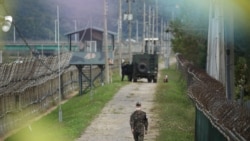North Korea’s latest missile launch involved a new hypersonic weapon, state media said Wednesday, the country’s first test of an advanced missile system that would add yet another unpredictable component to its fast-expanding arsenal.
The state-run Korean Central News Agency (KCNA) posted its first picture of the hypersonic missile, dubbed Hwasong-8, being launched Tuesday against the backdrop of a cloudy morning sky in the northern North Korean province of Jagang.
The KCNA report claimed the test was successful, adding that the hypersonic weapon was one of five “top-priority tasks” of a five-year defense plan outlined by North Korean leader Kim Jong Un at a major political meeting in January.
“[The test] confirmed the navigational control and stability of the missile in the active section and also its technical specifications including the guiding maneuverability and the gliding flight characteristics of the detached hypersonic gliding warhead,” KCNA reported.
Defense experts say North Korea’s development of the so-called hypersonic glide vehicle (HGV) is the latest evidence it seeks the ability to penetrate U.S. missile defenses, both in Northeast Asia and the U.S. mainland.
Like most ballistic missiles, HGVs fly at hypersonic speeds, or faster than five times the speed of sound. But HGVs are in theory more difficult to detect and intercept, since they can fly at relatively low altitudes and be maneuvered in flight.
“A hypersonic missile would provide another means of precisely striking targets on the peninsula through allied missile defenses,” says Adam Mount, a senior fellow at the Federation of American Scientists.
The big strategy: to evade, overwhelm
Since it resumed major missile tests in 2019 amid a breakdown in talks with the United States, North Korea has unveiled multiple weapon systems designed to overwhelm or evade U.S. missile defenses.
Those new systems include a long-range cruise missile tested earlier this month, as well as short-range ballistic missiles that can be guided in flight.
The North has also unveiled technology allowing it to launch missiles from road-mobile vehicles, trains, and eventually even submarines — making its arsenal more undetectable, and therefore more survivable in a possible war.
Though not all the weapons have been deployed or even fully tested, taken together they form a formidable threat to the United States and its allies, analysts warn.
“With so many capabilities being demonstrated but not fully tested, the (U.S.-South Korea) alliance will have to be ready for anything in a crisis,” Mount told VOA.
Why the latest missile is different
The hypersonic missile launched Tuesday appears to share some similarities with the KN-23, a short-range ballistic missile the North first tested in May 2019.
Like the KN-23, HGVs fly at a relatively low altitude and can be maneuvered in flight. However, the North’s newest missile features a warhead that detaches from the booster rocket before gliding to its target.
That feature may allow it to be attached to much bigger missiles than the KN-23, says Vipin Narang, a nuclear and defense specialist at the Massachusetts Institute of Technology.
“This atop a mobile solid fuel (intercontinental ballistic missile) would pose a big problem for the U.S. — it could be hard to find, and the warhead difficult to intercept by homeland defenses,” Narang told VOA.
A ‘major step’ in missile fuel capabilities
Missile experts are also concerned about North Korea’s claim of using a much quicker and more stable process to fuel its missiles.
The KCNA report Wednesday said North Korean scientists used the HGV test to introduce the “ampulization” of missile fuel.
The development means North Korea would be able to fuel missiles in a factory, seal them hermetically in canisters, and store them so that they can be moved out quickly and launched promptly, Narang says.
“They have so many liquid fuel missiles. Now they may not take hours to fuel in the open where they are vulnerable. Big leap in survivability and promptness,” he added.
The wider strategy
North Korea has now conducted three major missile tests this month. Few, if any, analysts think Pyongyang will stop the tests anytime soon.
In a speech late Monday at the United Nations General Assembly, North Korean diplomat Kim Song defended his country’s nuclear missile advancement, calling it a response to the “hostile policy” of the United States and South Korea.
“Nobody can deny the righteous right to self-defense for (North Korea) to develop, test, manufacture and possess the weapons systems equivalent to the ones which are possessed or being developed by” the United States and South Korea, Kim said.
The North Korean ambassador also condemned the presence of U.S. troops in South Korea, recent U.S.-South Korea military exercises and South Korea’s military buildup.
The comments came just days after Kim Yo Jong, the powerful sister of Kim Jong Un, held out the possibility of negotiations with South Korea.
The mixed messages are part of a time-tested strategy for North Korea, which wants to both build up its nuclear deterrent and divide the U.S.-South Korea alliance, says Mason Richey, a professor at South Korea’s Hankuk University of Foreign Studies.
The situation is especially difficult for South Korea’s left-leaning administration, which wants to resume talks with North Korea before President Moon Jae-in’s single term in office expires in May.
“If it calls these tests provocative, the Kim regime can claim that South Korea is hostile, and shut the door to engagement; if Seoul refrains from language Pyongyang doesn’t like, it will likely cause alliance friction with the U.S.,” Richey says.
There is no evidence the U.S.-South Korea alliance is fraying. But as Richey points out, the North’s strategy does seem to be intensifying a Korean arms race, which has “destabilizing security implications for both the Korean peninsula and the Northeast Asia region.”





